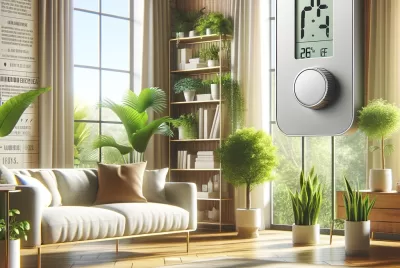What is a Humidifier Used For? For Better Indoor Air Quality
"We may earn a commission for purchases made using our links. Please see our disclosure to learn more."
Have you ever caught yourself pondering, What is a humidifier used for? Imagine waking up to smoother skin, comfortable breathing, and a sense of freshness in your living space, especially during those harsh winter months. If that sounds like a dream, a humidifier could turn it into your everyday reality.
Unlocking the Secrets of Humidifiers
If you’ve battled with flaky skin, chapped lips, or that persistent cough, a humidifier isn’t just a device; it’s a game-changer. Dive into this guide to understand everything there is to know about this wonder gadget – from its diverse benefits, the different types available, to its optimal usage and maintenance. Discover how the right humidifier could be the missing piece to your comfort puzzle.
Why Do People Love Humidifiers?
Behind this simple question of “What is a humidifier used for?” lies a range of solutions to common issues:
For the Self-Care Enthusiast: It’s like gifting your skin a natural, hydrating spa. Say goodbye to dry skin and chapped lips.
For the Seasonal Sufferer: Ease sinus congestion, clear those headaches, and soothe that dry throat. No more dreading those cold months.
For the Vocalist and Speaker: Keep your vocal cords smooth and irritation-free. Your voice, uninterrupted.
For Every Home Lover: Protect your home aesthetics by preventing wallpaper cracks and enjoy the added bonus of reduced static electricity.
For the Budget-Conscious: Feel a warmer ambiance without turning up the heater, a subtle way to cut down on winter energy costs.
However, a word to the wise: while humidifiers can be a sanctuary for comfort, improper usage or neglect in cleaning can have its drawbacks. It’s essential to keep them in optimal condition for the best results.
Understanding the Magic Behind Humidifiers
Delving deeper into the “What is a humidifier used for?” mystery, these are more than just devices. Humidifiers gently release water vapor, caressing your skin and pampering your lungs with the right moisture levels. Especially crucial in arid areas or during heating-intensive winters, they maintain a balance, ensuring the air around you is neither too dry nor too damp.
B. History of the invention and development of humidifiers
The first humidifier was invented in the early 20th century and was used primarily in hospitals to help patients with respiratory problems. Over time, humidifiers became more widely used in homes and offices, and with advancements in technology, they have become more efficient and effective at adding moisture to the air.
Humidifier usage guide
- A humidifier is used to improve indoor air quality and alleviate dry skin, respiratory problems, allergies and asthma.
- People living in dry climates, individuals with respiratory problems, and those with dry skin can benefit from using a humidifier.
- To choose the right humidifier, consider room size, type of humidifier, maintenance requirements, and features. Be sure to properly fill, adjust, and maintain the humidifier to avoid common problems such as mold growth, mineral buildup, and bacterial contamination.

What is a Humidifier and How Does it Work?
A. Definition of a humidifier
A humidifier is a device that adds moisture to the air to increase humidity levels in a room. There are several types of humidifiers, including ultrasonic humidifiers, evaporative humidifiers, and steam humidifiers.
B. Types of humidifiers
-
Ultrasonic humidifiers
Ultrasonic humidifiers use high-frequency vibrations to produce a fine mist of water droplets that are released into the air. They are quiet and energy-efficient, making them a popular choice for bedrooms and nurseries.
-
Evaporative humidifiers
Evaporative humidifiers use a fan to blow air through a wet wick or filter, which absorbs water from a reservoir and releases it into the air. They are affordable and easy to maintain but can be noisy and require frequent cleaning to prevent mold growth.
-
Steam humidifiers
Steam humidifiers boil water to produce steam, which is released into the air. They are effective at adding moisture to the air and can help alleviate respiratory problems, but can be expensive to operate and require more maintenance than other types of humidifiers.
C. How do humidifiers add moisture to the air?
Humidifiers add moisture to the air by emitting water vapor into the room. The water vapor can be absorbed by the skin and lungs, providing relief for dry skin and respiratory problems.

Benefits of Using a Humidifier
A. Alleviating dry skin
Dry air can cause skin to become dry, itchy, and cracked. Humidifiers can help alleviate these symptoms by adding moisture to the air, which can be absorbed by the skin.
B. Improving indoor air quality
Dry air can also cause respiratory problems and make it easier for viruses and bacteria to spread. Humidifiers can help improve indoor air quality by adding moisture to the air, which can help reduce the risk of infections.
C. Reducing the risk of infections
Humidifiers can help reduce the risk of infections by keeping nasal passages and airways moist, which can help prevent viruses and bacteria from spreading.
D. Preventing damage to home furnishings
Dry air can cause wood furniture to crack and warp, and can damage electronics and musical instruments. Humidifiers can help prevent this damage by adding moisture to the air.
E. Helping people with respiratory problems, allergies, and asthma
Humidifiers can help people with respiratory problems, allergies, and asthma by adding moisture to the air, which can make it easier to breathe. However, it’s important to consult a doctor before using a humidifier, as too much moisture in the air can exacerbate certain respiratory conditions.
Who Can Benefit from Using a Humidifier?
A. People living in dry climates
People living in dry climates can benefit from using a humidifier to add moisture to the air and alleviate dry skin and respiratory problems.
B. Individuals with respiratory problems
Individuals with respiratory problems, such as asthma and allergies, can benefit from using a humidifier to keep nasal passages and airways moist, which can make it easier to breathe.
C. Those with dry skin
Those with dry skin can benefit from using a humidifier to add moisture to the air, which can be absorbed by the skin and alleviate dryness and itching.

How to Choose the Right Humidifier for Your Home
A. Room size considerations
When choosing a humidifier, it’s important to consider the size of the room where it will be used. A small room will require a smaller humidifier, while a larger room will require a larger humidifier.
B. Type of humidifier selection
There are several types of humidifiers to choose from, including ultrasonic, evaporative, and steam humidifiers. Consider the pros and cons of each type before making a decision.
C. Maintenance requirements overview
Different types of humidifiers have different maintenance requirements, so it’s important to choose one that is easy to clean and maintain.
D. Features of different humidifiers
Consider the features of different humidifiers, such as automatic shut-off and adjustable humidity settings, when making a decision.

How to Use a Humidifier
A. Filling the humidifier with water
Before using a humidifier, fill it with clean, distilled water, and follow the manufacturer’s instructions for filling and cleaning.
B. Adjusting the settings
Adjust the humidity settings based on the size of the room and the desired humidity level. It’s important not to over-humidify a room, as this can lead to mold growth and other problems.
C. Proper cleaning practices
Clean the humidifier regularly to prevent mold and bacteria growth. Follow the manufacturer’s instructions for cleaning and maintenance.
D. Maintenance tips
Replace the filter or wick regularly, and empty and clean the water tank daily. It’s also important to store the humidifier properly when not in use.
| Problem | Cause | Solution |
|---|---|---|
| Mold growth | Accumulation of mold in the water tank or on the humidifier’s surface | Clean the humidifier regularly with a solution of water and vinegar or hydrogen peroxide. Refill the tank with clean, distilled water. |
| Mineral buildup | Mineral deposits from tap water left behind after water evaporates | Use clean, distilled water and clean the humidifier regularly to prevent mineral buildup. |
| Bacterial contamination | Bacteria in the water tank or on the humidifier’s surface | Clean the humidifier regularly with a solution of water and vinegar or hydrogen peroxide. Refill the tank with clean, distilled water. |
Common Problems with Humidifiers
A. Mold growth prevention
Mold growth is a common problem with humidifiers, especially if they are not cleaned regularly. To prevent mold growth, clean the humidifier regularly and use clean, distilled water.
B. Mineral buildup prevention
Mineral buildup can occur in humidifiers, especially if they use tap water. To prevent mineral buildup, use clean, distilled water, and clean the humidifier regularly.
C. Bacterial contamination avoidance
Humidifiers can harbor bacterial contamination, especially if you do not clean them regularly.. To avoid bacterial contamination, clean the humidifier regularly and use clean, distilled water.
Frequently Asked Questions About Humidifiers
A. How often should I clean my humidifier?
You should clean your humidifier at least once a week, or more often if it is used frequently.
B. Can I put essential oils in my humidifier?
Some humidifiers are designed to be used with essential oils, but not all. Check the manufacturer’s instructions before adding essential oils to your humidifier.
C. Can a humidifier make you sick?
If not maintained properly, humidifiers can harbor bacteria and mold, which can make you sick. To avoid this, clean your humidifier regularly and use clean, distilled water.
Personal Story: How a Humidifier Helped Me Get Through the Winter
Living in a city with harsh winters can be tough, especially if you have dry skin and respiratory issues. Last winter, I decided to invest in a humidifier to see if it would make a difference. I purchased an ultrasonic humidifier that was recommended for my apartment size and set it up in my bedroom.
Within days, I noticed a significant improvement in my skin. It was no longer dry and itchy, and I didn’t have to constantly apply lotion. I wasn’t waking up with a sore throat or stuffy nose anymore and could breathe easier and sleep more comfortably.
I was surprised to find that the benefits of the humidifier extended beyond my personal health. My apartment felt less stuffy and smelled fresher. I also noticed that my wood furniture wasn’t cracking as much as it had in previous winters.
Using the humidifier was easy, and I quickly got into the habit of filling it up with water and adjusting the settings as needed. I made sure to clean it regularly to prevent any mold or bacteria growth.
Overall, choosing to invest in a humidifier significantly improved my comfort and health during the winter months. If you’re experiencing similar issues, I highly recommend giving a humidifier a try.
Conclusion
A. Summary of key points
Humidifiers are devices that add moisture to the air, improving indoor air quality and creating a more comfortable living environment. They can alleviate dry skin and respiratory problems, reduce the risk of infections, and prevent damage to home furnishings.
B. Final thoughts on the benefits of using a humidifier
Using a humidifier can have many benefits for your health and home. It’s important to choose the right type of humidifier for your needs, maintain it properly, and follow the manufacturer’s instructions for use.
C. Improve indoor air quality and alleviate dry skin and respiratory problems.
If you’re experiencing dry skin, respiratory problems, or other symptoms related to dry air, consider purchasing a humidifier for your home. By following the tips in this ultimate guide, you can choose the right humidifier for your needs, use and maintain it properly, and enjoy the many benefits of improved indoor air quality.



